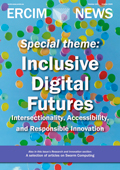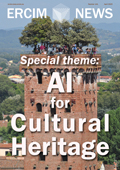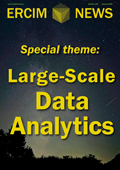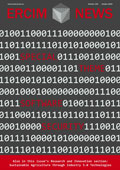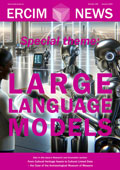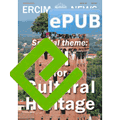by Michalis Mountantonakis and Yannis Tzitzikas (FORTH-ICS and University of Crete)
TCRMQ (Text-2-CIDOC-CRM Query) is a research prototype that can generate SPARQL queries over CIDOC-CRM Knowledge Graphs using a novel two-stage ontology path pattern method and Large Language Models (LLMs). The generated SPARQL queries can include in the filtering conditions information that are not even part of the KG, by exploiting knowledge from the LLM.
There is a strong need for exploiting Artificial Intelligence (AI) techniques, to enhance the accessibility and reusability of Knowledge Graphs (KGs) of Cultural Heritage domain, which have been modelled through the CIDOC-CRM ISO Standard [1]. Hence, a relevant task is to enable the answering of natural questions over CIDOC-CRM based KGs, by generating SPARQL queries from a given natural question. This is a highly challenging task, especially for sophisticated (event-based) ontologies like CIDOC-CRM, since in most cases one has to derive queries with long property path expressions to answer a given question [2]. To tackle this difficulty, we present the research prototype TCRMQ (i.e., Text-2-CIDOC-CRM Query) [L1], which is an application that can generate SPARQL queries over CIDOC-CRM KGs, by exploiting a novel two-stage ontology path pattern method that combines knowledge from a given KG and from Large Language Models (LLMs) [2].
Regarding the functionality, as we can see in Figure 1, TCRMQ receives a question from the user in natural language, such as “Give me the number of artworks for each artist born after the end of the first World War” and then the user selects a method and the desired KG to answer the given question. The application uses a novel two-stage method combining Ontology Path Patterns and Knowledge from LLMs [2] for generating the SPARQL query. First, the method sends a prompt with candidate ontology path patterns and receives a prediction with the most relevant path patterns for answering the question. Then, a second prompt is sent to the LLM, for generating the SPARQL query for the given question, based on the predictions. For instance, in Fig. 1, TCRMQ managed to predict the long property path that connects an artwork with the corresponding artist and his/her birth date, and then it generated the corresponding multi-hop SPARQL query. Subsequently, the generated SPARQL query (see the bottom-left part of Figure 1) is sent to the SPARQL endpoint of the desired KG and the application retrieves the answer and presents the results of the query to the user (see the right part of Figure 1).

Figure 1: The functionality of the TCRMQ research prototype.
A very interesting finding regarding the synergy between LLMs and KGs is that LLMs “know” background knowledge (dates, names, etc.) that is not present in the KG, and this synergy can yield queries with the right filtering conditions, even if such information is not present in the KG. For example, in Figure 1, the KG did not contain any information about the dates of the First World War. However, LLMs (such as ChatGPT) include this relevant information and, in our case, the LLM added the desired date in the filtering condition of the SPARQL Query (i.e., “1918-11-11”). Another functionality of the TCRMQ is that the user can (i) compare several methods (based on different prompts) for generating the SPARQL query, (ii) use different ChatGPT versions (currently it supports versions 3.5, 4-mini and 4), (iii) ask a question in languages other than English, and iv) edit the generated SPARQL query, e.g., to restrict the results and/or to correct possible errors in the generated query.
Concerning evaluation results, we have tested the methods of TCRMQ by using a benchmark [L2] with 100 questions over two real CIDOC-CRM based KGs including data about artworks. The benchmark consists of five categories of questions, i.e., each category includes 20 questions requiring a path with length a) 1, b) 2, c) 3, d) 4 and e) mixed paths (combining paths of different length). The evaluation was performed by using the ChatGPT version 3.5. Regarding the results, we managed to generate the correct SPARQL query for 66 out of the 100 questions [2], by using the two-stage method, whereas the corresponding accuracy for the baseline method was 19 out of 100 questions. As regards the different categories of questions, the accuracy was lower for questions requiring following either a path of length 4 or a mixed path, compared to the other categories. In the most erroneous cases, either a totally incorrect path or a longer path was selected. All the details for the benchmark and the evaluation can be found in the paper [2] and on the GitHub page [L2].
As future work, we plan to evaluate the methods by also using newer versions of ChatGPT, by also expressing the questions in other languages, to add more KGs in an automatic way (including also other KGs using event-based models) and to perform an analysis of the path patterns of all the available CIDOC-CRM KGs.
Links:
[L1] https://demos.isl.ics.forth.gr/Text2CIDOC/
[L2] https://github.com/mountanton/CIDOC-QA-using-LLMs
References:
[1] Y. Tzitzikas, et al., “CIDOC-CRM and machine learning: a survey and future research”, Heritage, 5(3), pp.1612-1636, 2022.
[2] M. Mountantonakis and Y. Tzitzikas, “Generating SPARQL Queries over CIDOC-CRM using a Two-Stage Ontology Path Patterns Method in LLM Prompts”, ACM Journal on Computing and Cultural Heritage, 18, 1, Article 12, March 2025, 20 pages. https://doi.org/10.1145/3708326
Please contact:
Michalis Mountantonakis
FORTH-ICS and University of Crete, Greece
Yannis Tzitzikas
FORTH-ICS and University of Crete, Greece

